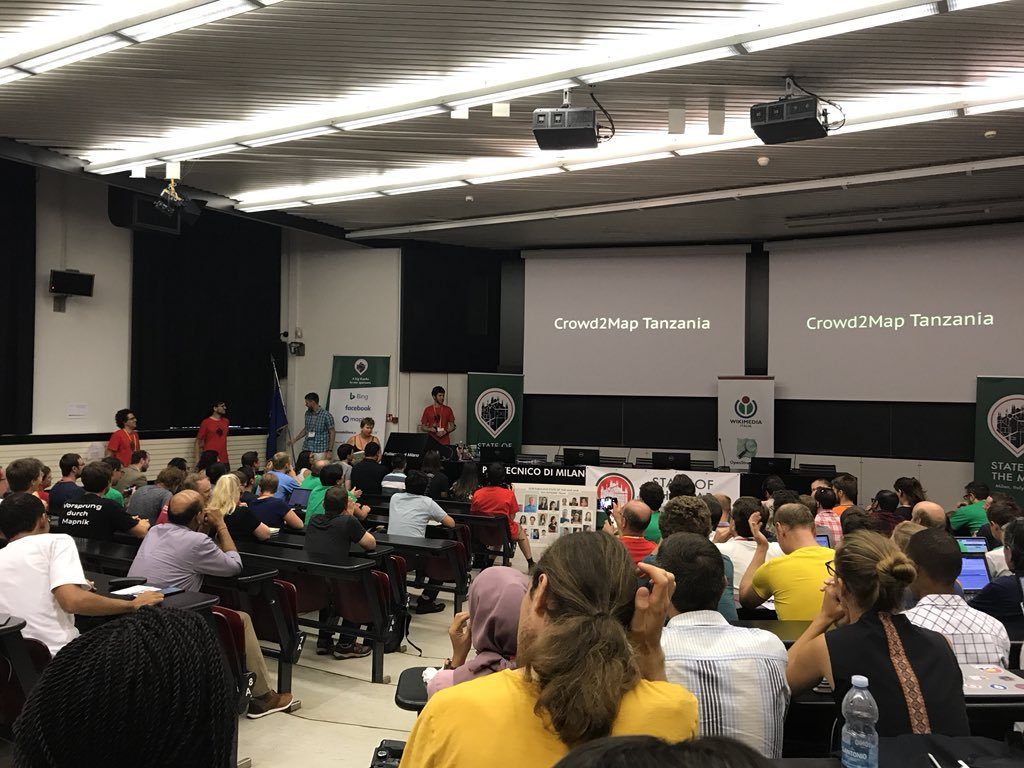It’s difficult to detect patterns in the huge variety of experiences and perspectives in the responses to the OSM community survey. What is clear from the responses of over 300 people (thank you all!) is that community is valued, important and desired; as well as complicated, and energy and time consuming. One common thread is the need for more support for community building efforts. The specific ideas for that support vary so much, as well as who and how to marshal the effort.
Communities vary from isolated mappers who only see others editing on the map but don’t connect online or offline in person, to places with a full formal organized presence. But an organization doesn’t guarantee a growing, connected and vibrant community. Most places are in between, from a few friends coordinating together closely, to a core group with ‘fly by tourist mappers’, to places with regular meetups and local conferences. The scope of what people consider their community varies from an individual city or region, to an entire country, to being a part of several places. Many feel disconnected or unconcerned with the “global community”, though some feel the global community is their community, with unique issues and dynamics of its own. The communication channels people prefer are probably only going to grow from the large list we have already.
Yes, you can say that anyone who bothers to answer this survey would be a biased self selected sample, and of course would care about community. Someone happily mapping without talking to anyone wouldn’t care about a survey, and certainly there are some people who are happy to edit OSM without talking to others. But, these community connections — online and offline in person — are widely agreed as the key to what makes OSM work. A bunch of disconnected people editing a database without talking to each other would fail. We can do more together than apart. The means to connect and support all these communities is the major challenge.
Below we present some of the numbers from the quantitative questions, and some individual reflections from the Board. We don’t anticipate this is the only post from this survey; there’s a lot to work through here, so likely more to come.
You are welcome to read and draw your own conclusions from the anonymous answers to the set of narrative questions on community; find those shared at the bottom of this post.
Stats
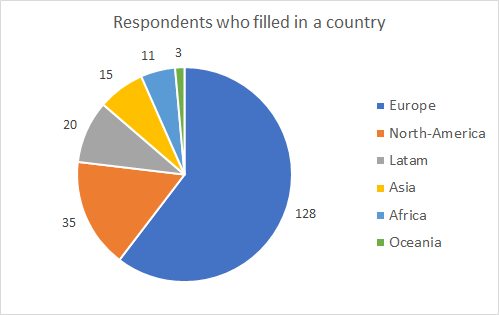
This survey was filled in by people who saw the link and decided to fill it out. So it is obviously not a random sample of the OSM community. That was always the plan, but it means we should tread with care to generalize. For example, if we see that many Latin Americans in our sample are using Telegram, that might just mean that by chance the link has only been visibly shared on that network.
Although we had 310 useful responses, not everyone filled out the interesting free text questions. For example, the first block of open questions was answered (at least partially) by 204 people.
Volunteers translated the survey itself, as well as the answers. This was a huge job, as there were 139 people who filled in the survey in Spanish, German, French, Italian, Hungarian, Portuguese, Farsi, Chinese and Lithuanian.
Background
People could mark any of the below to describe their involvement in OSM. People who didn’t mark anything aren’t included in the graph below.
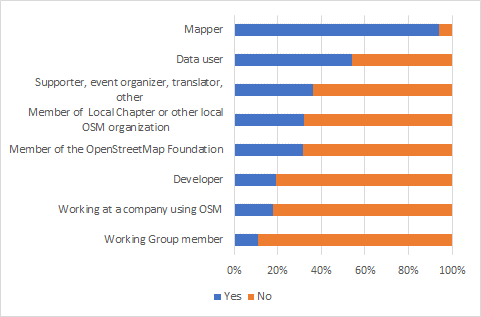
Communications channels
The graph below shows the communication channels sorted by number of readers. Thematic and local mailing lists together are the most widely read, as well as contributed-to channels.

We look forward to dig further into the data. One thing we already did, was have a look at how the communication channels differ by region. The below graph shows the percentage of people by region who follow a certain channel. This brings up some interesting data points. For example, mailing lists seem most popular in Asia and least in Africa. The Weekly and the blog are underrepresented in Latin America. Telegram is popular there (and to a lesser extent in Asia), Slack in North-America and Facebook in Asia and Africa. The forum stands out by being so consistent. There were only 3 responses from Oceania, so can not draw any pattern from those.
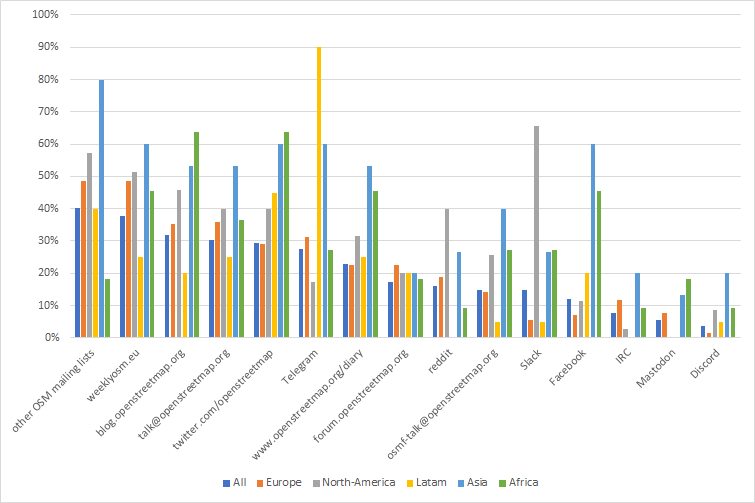
Countries
People from 45 different countries filled in the survey.
Germany – 35
US – 33
Italy – 17
France – 16
UK – 15
Spain – 11
Argentina – 7
Hungary – 7
Switzerland – 7
5 or less respondents
Brazil
Guinea
Philippines
Australia
Belgium
India
Portugal
Canada
Colombia
Denmark
Japan
Lithuania
Nigeria
Paraguay
Poland
Sweden
Belarus
Bolivia
Europe
Indonesia
Iran
Ivory Coast
Kazakhstan
Luxembourg
Malaysia
Mexico
Panama
Peru
Romania
Russia
South Africa
Taiwan
Thailand
Togo
Uganda
Ukraine
Reflections from board members
from Joost
Is there a community? Do you meet other mappers? Some of you seemed surprised by the very question. And in other places, there is more going on than you can follow. But national activity is not enough. Even if there’s for example an Italian community, people organize in their own more local area. Some of these groups are really inspiring – and though the OSM weekly does a great job highlighting what’s happening everywhere, we still picked up things we hadn’t heard of. A suggestion was a yearly report on what is happening locally. We were pleasantly surprised to hear about what is happening in for example Bretagne or Piedmonte. But then in a place like New York City, even if a lot of things happened in the past, current heavy mappers might feel rather alone. A different kind of struggle happens in low population places, where mappers are just too far apart.
from Mikel
In the early years of OpenStreetMap, it was easy to just do it. If you had an idea and energy, there was nothing but space to try things out. After 15 years, OSM has grown enormously, accreted data, communication channels, cultural practices and history, and its harder to see ideas through to actualization. There’s still no shortage of inspiration, as the ideas in the survey show. How can we cultivate the space to make it easy to just try things out again?
To name a few ideas that stuck out for me: annual reports, grants, “twinning” chapters, individuals who “bridge” communities, community building training, informal planned live chats between communities.
Exciting and exhausting. It’s takes energy for all these things. Take one example: microgrants. The jury is out on whether this will help build community or not, but that’s certainly the intention. The OSMF Board have wanted to do this for years. We’re actually fairly close to launching this finally, but it’s taken so long.
In the middle of reviewing the responses, I had to do something, so I built an interactive map from of the OSM Community Index. Yet another map solves nothing, but satisfying to see our presence across the globe, and think about better ways to share what’s happening between us.
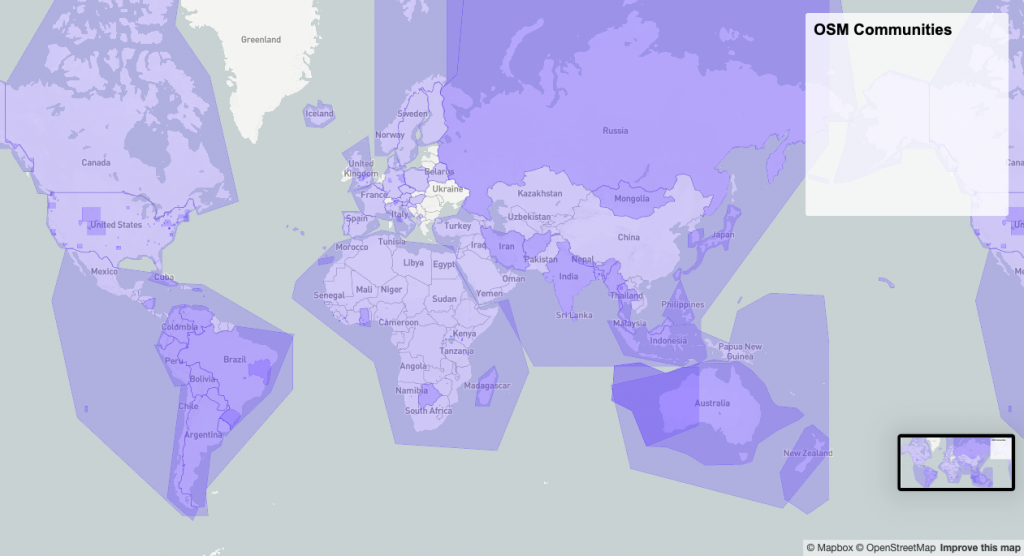
Excited to talk about this all in Heidelberg! Especially think the Local Chapter Congress can be a place to pick up some of these topics.
from Heather
OSMF should consider a community engagement plan to further delve into the needs of the ‘community of communities.’ There is a large potential to, with a data-enabled process, make some ‘light-touch’ adjustments to improve the health of the network. This should be done in consultation with the various groups across OSM. We need to buid on activities, events, and surveys to a more inclusive, distributed plan.
from Frederik
Browsing through the answers we got here, I see a serious need for arbitration in the future. The issues people want prioritized are often contrary – one person wants more of something, the other wants to ban the same thing altogether. There are many issues on which the OSMF hasn’t defined for themselves a clear standpoint, and for good reason – because even without a survey it was clear that opinions differ greatly. Many people seem to expect things from the OSMF that would far exceed its current, established mandate. Does that mean the OSMF should expand its influence – or have those who want the OSMF to stand back and shut up simply not participated?
from Tobias
The survey responses seem to demonstrate a considerable appetite for a more unified OSM community communication platform. At the same time, they also make it clear that we often look for very different things in communication channels, and that preferences regarding the existing ones also vary wildly between contributors, making this a challenging situation for our project. I believe it’s important to continue improving OSM’s own communication platforms, which might mean technological updates as well as working on our social dynamics. Our goal should be spaces that people enjoy visiting and productively contributing to. If we succeed in this effort, we might even win over some contributors who currently choose to use third-party tools.
Several participants shared their insights about local events and meetups: The benefits for motivation and community building, but also their struggles in getting regular meetings off the ground or keeping existing groups alive. While these initiatives must ultimately be run by local community members, the OSMF should explore possibilities to offer support. Suggestions from the survey included making existing groups more visible on the OSM website, providing tools for finding other local contributors interested in such events, and improving the osm.org messaging tools.
Although not strictly about communication and communities, the more open-ended questions saw many of the pressing issues from our previous survey brought up again – which should remind us that the OSMF, and the board in particular, must make faster and more visible progress on addressing them.
Finally, kudos to WeeklyOSM! While reading through the responses, it stood out to me how often this channel was mentioned in a positive light, especially given the controversial opinions on many other platforms. Providing an overview of the vast OSM landscape with its fractured platforms and sub-communities is an invaluable service.
Partial Dataset released
Many community members have allowed us to share their answers publicly, aggregated and anonymously. We are now sharing the answers to the first set of questions:
- What is happening in your local community?
- What about your local community should be more widely known? What can other communities learn from yours?
- Do you meet other mappers in person? Is there a local community beyond mapping?
- Are you engaged in the “global community”. If you aren’t, why not?
- What do you think could improve the interaction between global and local communities? How can you help?
- Do you know who organises the global State of the Map conference? If you’re going to SotM, why? If you’re not going to SotM, why not?
There were 158 individuals that have answered at least one of those questions and gave us permission to share their answers. You can find that partial dataset at the OSMF website.
If you prefer an online spreadsheet, we have also put them at framacalc, but please note that the OSMF spreadsheet is the definite reference.
The OpenStreetMap Foundation is a not-for-profit organisation, formed in the UK to support the OpenStreetMap Project. It is dedicated to encouraging the growth, development and distribution of free geospatial data for anyone to use and share. The OpenStreetMap Foundation owns and maintains the infrastructure of the OpenStreetMap project, is financially supported by membership fees and donations, and organises the annual, international State of the Map conference. It has no full-time employees and it is supporting the OpenStreetMap project through the work of our volunteer Working Groups. Please consider becoming a member and read about our fee-waiver program.
